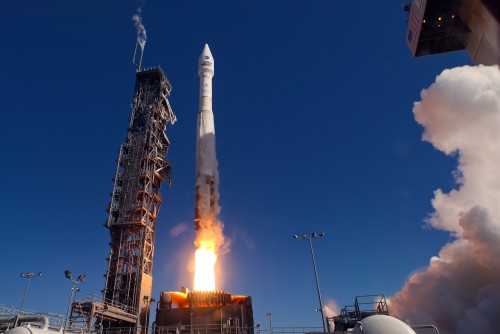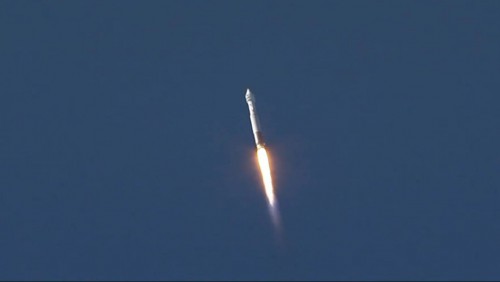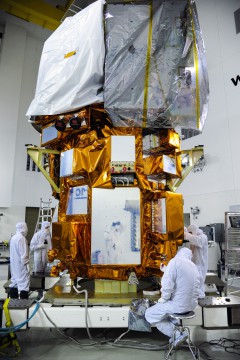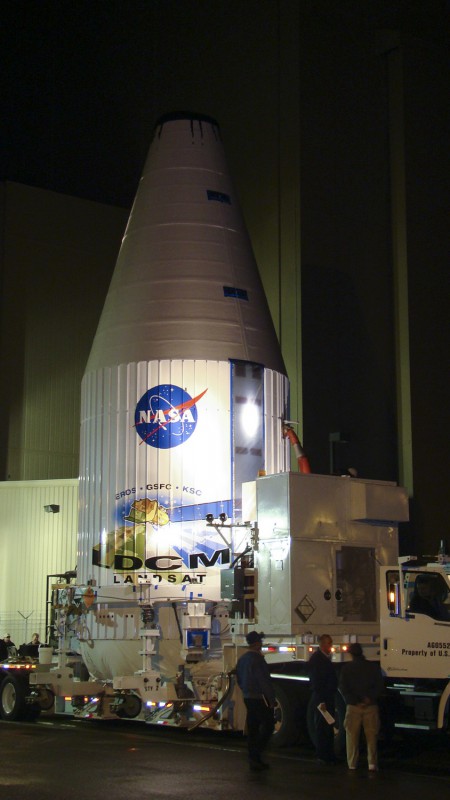
A new Earth-watching sentinel is presently circling the globe in near-polar orbit, following today’s beautiful launch of the Landsat Data Continuity Mission (LDCM) from Vandenberg Air Force Base, Calif. The spacecraft—which represents the eighth in a series of satellites, dating back to July 1972—was successfully boosted aloft by United Launch Alliance’s Atlas V rocket at 10:02 a.m. PST (1:02 p.m. EST), right on the opening of the 48-minute “window.” Liftoff occurred from Vandenberg’s Space Launch Complex (SLC)-3, under clear skies, and was watched by NASA Administrator Charlie Bolden and Interior Secretary Ken Salazar.
The launch kicks off a planned five-year mission, which will provide moderate-resolution imaging of the Home Planet’s terrestrial and polar regions at visible and infrared wavelengths. This is expected to support future land planning, disaster response, and water-use monitoring, together with maintaining a watchful eye on Earth’s climate, ecosystems, water cycle, surface, and interior dynamics. The LDCM spacecraft is part of a collaborative effort between NASA and the U.S. Geological Survey. According to Project Scientist Jim Irons of NASA’s Goddard Space Flight Center in Greenbelt, Md., it is quite simply “the best Landsat satellite yet launched in terms of quality and quantity of data.”

LDCM rose from Earth atop ULA’s venerable Atlas V, which flew in its “401” configuration, with a 4-meter (13-foot) payload fairing, no strap-on rocket boosters and a single-engine Centaur upper stage. The 401 is identical to that adopted for NASA’s latest Tracking and Data Relay Satellite (TDRS-K), which was successfully boosted into orbit from Cape Canaveral Air Force Station, Fla., on 30 January. Since its maiden voyage in August 2002, the Atlas V has flown 36 times, including today’s mission, with a near-perfect launch record—the only blemish was a Centaur problem in June 2007, which produced a lower than intended orbit for its classified National Reconnaissance Office payload. The giant booster, which stood 19 stories tall, was exposed this morning when the SLC-3 gantry was retracted, ahead of the loading of cryogenic propellants.
“We are privileged to work together with NASA and such a strong LDCM mission team,” said Jim Sponnick, ULA vice president, Mission Operations. “This is the second NASA mission ULA has launched in just 12 days. The ability to successfully execute this launch rate is a testament to a very dedicated and skilled workforce, excellent teamwork with our NASA customer and all of our mission partners, and a one-launch-at-a-time focus that enabled both the TDRS-K launch on Jan. 30 and today’s LDCM launch, both of which delivered critical capabilities to orbit.”

Under mostly clear skies at Vandenberg, the Atlas V’s RD-180 engine roared to life, two-and-a-half seconds before liftoff, and spooled up to its full 860,000 pounds of thrust at T-zero. This Russian-built engine is fed by liquid oxygen and a refined form of rocket-grade kerosene, known as “RP-1,” and burned for a little more than four minutes. Climb-out of the booster from SLC-3 began at T+1.1 seconds, and after clearing the tower the Atlas commenced a pitch, roll, and yaw maneuver to establish it on the proper flight azimuth for the injection of LDCM into orbit. The rocket followed a due-south trajectory and its ascent and orbital-injection telemetry was received at Vandenberg, together with the Hawaiian island of Oahu, RAF Oakhanger in Hampshire, U.K., and Thule Air Base, Greenland.
Shortly before the RD-180 cut-off, at T+242 seconds, the engine throttled back to limit acceleration loads and, upon its separation, the turn came of the 41-foot-long Centaur. The latter’s RL-10A engine—built by Pratt & Whitney Rocketdyne—was responsible for staging two “burns” to place LDCM into its near-polar orbit, some 438 miles high and inclined 98.2 degrees to the equator. Capable of restarting in flight, the RL-10A was at the center of a lengthy investigation last year, following an incident of abnormally low thrust during its otherwise successful effort to place a Global Positioning System (GPS) satellite into orbit. The first burn in support of LDCM lasted 11 minutes and placed the satellite and the Centaur into a “parking orbit,” after which the combo coasted for 55 minutes, before the execution of a second burn, lasting a little under two minutes. Seventy-eight minutes into the mission, the 6,100-pound spacecraft separated from the Centaur and began the lengthy process of deploying its solar arrays and scientific instruments.
Today’s smooth emplacement of LDCM into orbit comes at the end of an equally smooth processing flow for the spacecraft and the launch vehicle itself. The Atlas was erected on the SLC-3 pad surface in mid-October 2012 and a fully-fueled (or ‘wet’) countdown demonstration test was performed in early December. By this time, the LDCM payload fairing had also arrived at Vandenberg and on the 20th the spacecraft arrived in an oversized semi-trailer truck from prime contractor Orbital Sciences Corporation’s Gilbert, Ariz., facility. Last month, LDCM underwent comprehensive performance tests of its twin scientific instruments, its systems and its solar arrays, and its X-band communications antenna was installed. By mid-January, the spacecraft had been fueled and was encapsulated within its payload fairing on the 23rd. Two days later, it was transported to SLC-3 for integration atop the Atlas vehicle.

Landsat has a long and storied history, as described in Friday’s AmericaSpace preview article. Many of its missions greatly exceeded their expected life spans and on the eve of LDCM’s launch, two spacecraft – Landsats 5 and 7 – remained operational in orbit, with the former entering its 29th year of operations and the latter its 15th. Yet the arrival of LDCM is acutely needed, for the aging Landsat 5 has suffered serious difficulties in recent years, including an anomaly with its backup solar array drive, troubles with power and attitude control and, since November 2011, fluctuations in a critical data-transmission amplifier, all of which suggest that its mission will soon come to an end. Meanwhile, Landsat 7 is more or less fully functional, save an early malfunction in its Enhanced Thematic Mapper.
The flight of LDCM continues a proud record…and a free record, at that, for its data is freely available to investigators and the wider public for agriculture, geology, forestry, regional planning, education, mapping and global change research. The new mission is equipped with two scientific instruments. The Operational Land Imager is sensitive to the visible, near-infrared and shortwave-infrared part of the electromagnetic spectrum. Its images have 50-foot panchromatic and 100-foot multispectral spatial resolutions along a 115-mile swathe, allowing it to cover wide areas, yet still enabling it to adequately view urban centers, farms and forests. Meanwhile, the satellite’s Thermal Infrared Sensor will measure land surface temperatures in two thermal bands, using quantum well infrared photodetectors to detect long wavelengths of light emitted by the Earth.
Due to LDCM’s near-polar orbit, the entire planet will fall within view every 16 days. Not surprisingly, LDCM represents something of a capability leap, in that it will return more than 60 percent more imagery to the U.S. Geological Survey’s data archive, daily, than Landsat 7. No fewer than 400 scenes will be downlinked from the new satellite every day, compared to 250 for its predecessor. This is expected to increase the probability of capturing cloud-free scenes for the global land mass.
“Landsat is a centerpiece of NASA’s Earth Science program, and today’s successful launch will extend the longest continuous data record of Earth’s surface as seen from space,” NASA Administrator Charles Bolden said. “This data is a key tool for monitoring climate change and has led to the improvement of human and biodiversity health, energy and water management, urban planning, disaster recovery and agriculture monitoring — all resulting in incalculable benefits to the U.S. and world economy.”




Thanks to you folks, I watched this launch in real time…then read this article before they could clear the launch pad! Nicely done…need a live onsite photographer for the “Left Coast”!!
PS Ben Evans….your write-ups & historical information….FABULOUS…..”PRICELESS”…!!!!
Mary,
AmericaSpace is a small outlet – however we’d be happy to welcome reporters that could report on events at VAFB to our team!
Sincerely, Jason Rhian – Editor, AmericaSpace